Heritage 150P’s Optical Tube
The Sky-Watcher Heritage 150P is a 150mm (6”) f/5 Newtonian reflector with a focal length of 750 mm. This is the same optically as many 6” Newtonian astrographs, equatorially-mounted 6″ reflectors, and the 6” tabletop Dobsonians sold by Omegon, and others, most of which I’ve tested.
The main difference that I noticed between the Heritage 150P and other 6″ f/5 Newtonian reflectors is that the 150P has a collapsible tube (see Image 1 below), which essentially consists of the bottom half of one of those telescopes with a triad of struts and a plastic upper ring assembly replacing the upper half of the tube.
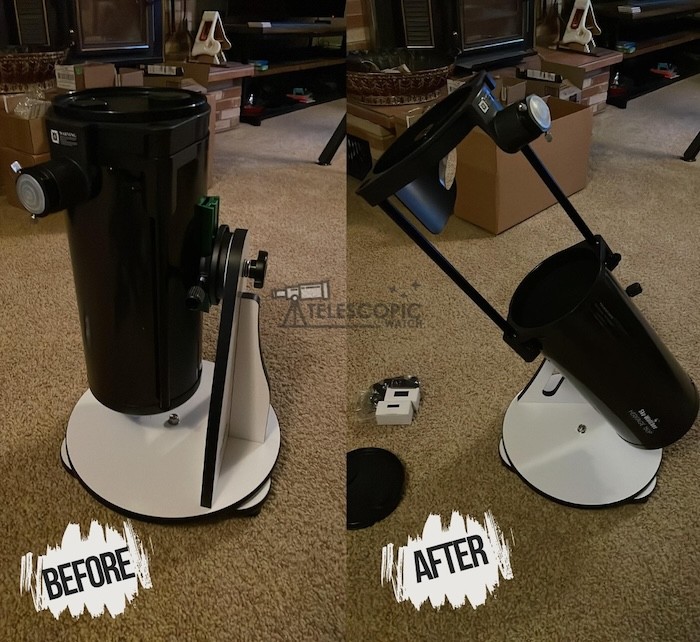
The obvious advantage of the collapsible system is that the telescope is significantly more compact by collapsing the upper half of the tube. That means it can fit in a large backpack, a suitcase, or in the trunk of even a very small car in a way that even a regular 6” f/5 Dobsonian just can’t.
However, there are several disadvantages.
The lack of a tube means that glare, moisture, and curious hands can get inside the tube. You can make a DIY shroud out of foam to alleviate this problem, but that’s another hassle to deal with too.
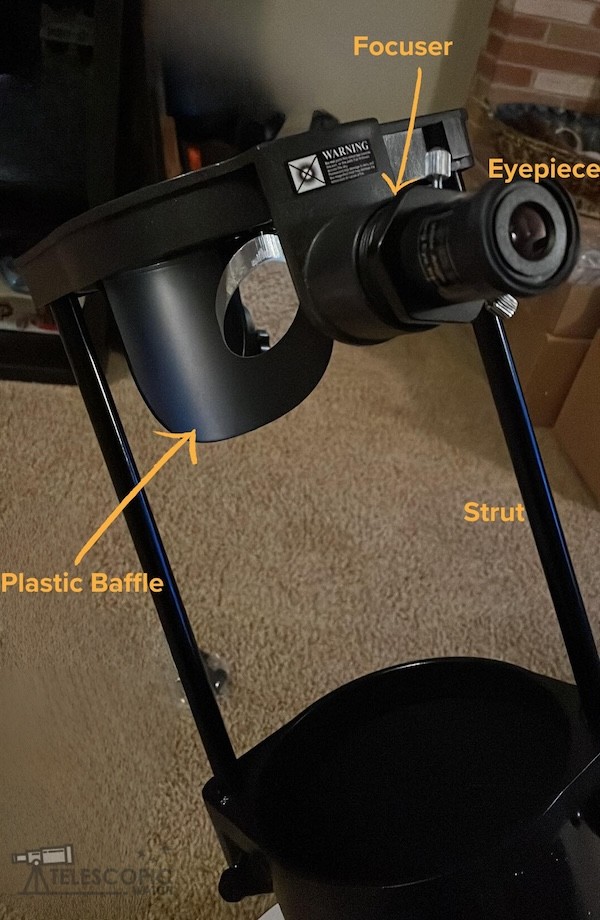
The plastic baffle (see Image 2) is wholly inadequate to block light pollution, glare from direct light sources, moonlight, or sometimes even the light of bright stars or planets from entering the eyepiece and causing glare and loss of contrast. I find the baffle itself to be shiny, defeating its purpose.
Due to the movement of the struts, in my experience, the Heritage 150P also tends to go out of collimation a little more often than a solid-tubed scope. But this is hardly more than a moderate inconvenience, and I always check collimation frequently with any telescope anyway.
I perceive the Heritage 150P’s focuser (see Image 2) to be perhaps the weakest link in the whole telescope. It is made of plastic and has the simplest helical design. For eyepieces like the ones included with the 150P, this is fine. But the helical focuser is not really capable of holding anything heavy, such as a nice ultra-wide-angle eyepiece or Barlow lens.
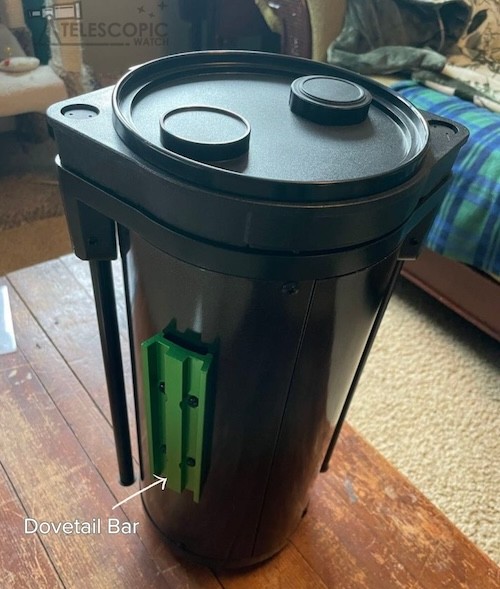
You could theoretically put the telescope on another mount because of the Vixen-style dovetail bar (see Image 3), but it’s possible this could result in the focuser/eyepiece being located in an awkward position.
Accessories
The Sky-Watcher Heritage 150P tabletop dobsonian includes two eyepieces: a 25mm “Super” providing 30x and a 10mm “Super” ocular providing 75x when used with the 150P.
Both eyepieces are 1.25″ in diameter, interchangeable, and made largely out of plastic, but they are good optically, and I found them comfortable to use.
The 10mm has more eye relief than a regular 10mm Plossl or Kellner and thus is a lot easier to look through, especially for children or beginners not used to centering their eye on the exit pupil of the eyepiece.
RECOMMENDED BUY FOR ADEQUATE ACCESSORIES
Both of the included Super eyepieces are pretty good, if a bit short of being perfect for an f/5 focal ratio instrument. I noticed some reflections that a higher-quality Plossl ocular won’t suffer from, but they make up for it with their ease of use. And for the low cost of the Heritage 150P, it’s hard for me to complain; some manufacturers sell 6” reflectors with only one included eyepiece for a much higher price.
Buy Heritage 150P from HighPointFor aiming the Heritage 150P, a red dot finder is provided, which attaches to a rail affixed to the front of the telescope. This is really all you need for aiming a wide-field instrument like the Heritage anyway, and a heavier finder would neither fit nor be secure on the small amount of real estate the upper part of the Heritage’s frame provides.
Its tabletop “Dobsonian” Mount
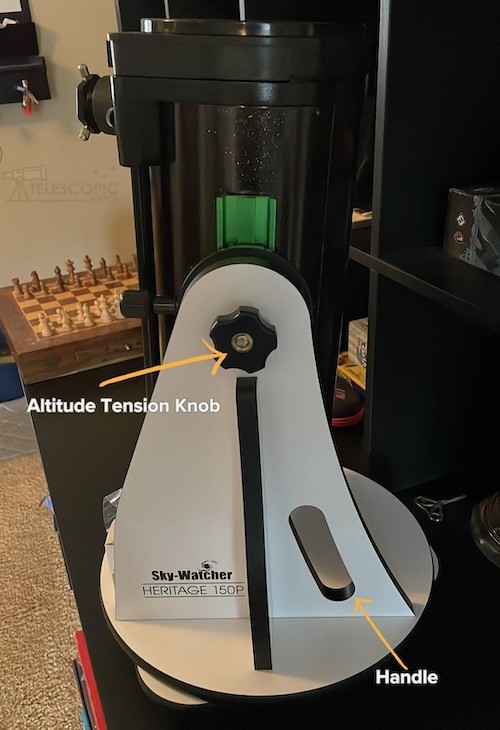
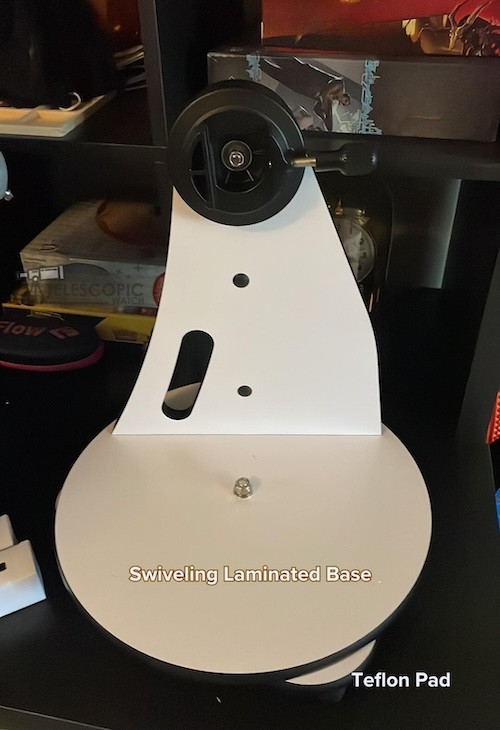
The Heritage 150P uses a tabletop “Dobsonian” mount—technically not a true Dobsonian but rather a one-armed fork design. The tube pivots up and down on a plastic pad and ball bearing and swivels like any other Dobsonian using three small Teflon pads on the laminated base (see above, Image 4).
The tube attaches to the mount with a Vixen-style dovetail rail and clamp and can be slid along the clamp for optimal balance. There’s also a built-in handle. While I can adjust the friction on the altitude axis by tightening a large knob (see above, Image 4), adjusting the friction on the azimuth axis requires a pair of pliers or wrenches.
Being a “tabletop” telescope, you’d think the Heritage 150P is best suited for use on a table, and counterintuitively, it isn’t at all. For one thing, almost any table is not going to be sturdy enough for the 150P or its smaller sibling, the 130P. The 150P is actually quite tall when assembled.
My pick would be either a sturdy plastic bin (which you could also store the scope in) or, my favorite, a milk crate. For children or seated adults, this is more than an adequate amount of elevation. It’s lightweight, and you can carry the Heritage 150P and accessories around in it.
Should I buy a used Sky-Watcher Heritage 150P?
Given that the Heritage 150P is a new product in Sky-Watcher’s lineup, the likelihood of encountering a decrepit or damaged unit is very low. However, the usual precautions apply: check to make sure the mirror coatings aren’t damaged, the trusses extend smoothly, and hopefully the base is in good shape. Damage to the plastic and metal body of the optical tube is very hard, if not impossible, to fix. Otherwise, a used 150P will make for a great scope.
Alternative Recommendations
Acknowledging the Heritage 150P’s standing as the top scope in its price range, I find most alternative recommendations to be either inferior or in another price category.
- The Sky-Watcher Heritage 130P is essentially just a shrunken 150P, which fits in a smaller space and has slightly more forgiving mechanics due to its smaller size.
- For a significantly higher price, there are a variety of full-sized, free-standing 6”, 8” and 10” Dobsonians which all provide great views in a simple and portable design format.
Aftermarket Accessory Recommendations
The Heritage 150P’s included two eyepieces are just fine, but the 10mm Super ocular only provides 75x, a far cry from the maximum of 200x or so that the scope is capable of under good conditions (300x is possible under above-average seeing conditions on some targets but may or may not be worthwhile).
A bit higher power (125x) can be achieved with a 6mm “gold-line,” which may be all you really want or need for most lunar and planetary viewing. A 4mm Aspheric or 4mm planetary eyepiece increases the magnification further, up to 188x, but is not our favorite.
A 2x Barlow with the stock 10mm will provide 150x, or 250x if used with the 6mm gold-line. So the best combination is probably a 6mm gold-line and a Barlow.
For a medium magnification between 30x and 75x, we might also recommend a 15mm gold-line (50x), which provides a good balance of field of view and magnification for viewing many deep-sky objects. If you’re willing to spend extra, there’s the SVBONY 15mm 70-degree with a wider and sharper field of view, as well as a more comfortable eyecup.
A “UHC” (ultra-high-contrast) narrowband eyepiece filter is also a great addition to the Heritage 150P. It screws onto your eyepiece and significantly enhances contrast in most emission nebulae, like the Orion Nebula, the Swan Nebula, or the Lagoon Nebula. It also brings previously-invisible nebulae like the Veil, Flame, and Rosette into view. A UHC isn’t magic—it won’t alleviate the effects of severe light pollution, nor does it work on stars, galaxies, etc.—but it’s a great observing tool to have.
We’d recommend a collimation tool for the 150P as well; unlike the Heritage 130P, which at least sometimes comes with a cheap Cheshire collimator, the 150P comes with no collimation tools whatsoever. You can collimate the 150P just fine with a bright star, but a real Cheshire or collimation cap is best. A cheap laser collimator is not only a poor choice but will likely make the 150P’s focuser and frame sag and thus provide inaccurate and frustrating results even if the laser itself is high quality, which most cheap lasers aren’t to begin with.
You may also want to make a custom stand and a shroud for the Heritage 150P to maximize its usefulness.
What can you see with the Skywatcher Heritage 150P?
A 6” telescope like the Heritage 150P can show you a lot of stuff, especially under dark skies, which it is thankfully very easy to transport to. Views of the Moon and planets are largely the same regardless of light pollution conditions, apart from the faint moons of the outer planets, where local atmospheric turbulence (seeing) is more important when it comes to getting the best clarity. However, for viewing galaxies, nebulae, and star clusters, it is best to get out into dark skies that are at least good enough that you can faintly see the Milky Way with your naked eye.
Within the solar system, the Heritage 150P can reveal the phases of Mercury during a favorable apparition of the planet, while Venus’ phases are an easy catch. The Moon shows thousands of craters as small as a few miles, along with cracks, ridges, fault lines, mountain ranges, and frozen lava flows. Mars’ polar ice cap is visible most of the time, and when Mars itself is close to Earth around opposition biannually, you’ll have no trouble seeing a few dark patches and any Martian summer dust storms, which usually tend to envelop the entire planet and obscure all other surface details. The two small asteroid moons of Mars, Phobos and Deimos, are also theoretically possible to observe but quite difficult. Deimos is the easier of the two and is still quite an achievement.
The Heritage 150P will show a wealth of festoons, storms, and cloud bands on Jupiter ranging from blue, to red, to tan, to pink, to gray and brown. The Great Red Spot is also clearly distinguishable, even as it continues to shrink over the years. You’ll also be able to see the 4 Galilean moons (Io, Europa, Ganymede, and Callisto) as tiny disks with equally tiny shadows when they transit across Jupiter and eclipse its cloudy surface.
Saturn’s rings and the Cassini Division within them are well-resolved with the Heritage 150P at high magnification, and several cloud bands on the planet itself can be seen, along with a gray-blue area near the poles. A few moons are also visible, including Titan, Rhea, Tethys, Dione, Enceladus, Mimas, and Iapetus, the latter of which is much harder to see depending on whether its dark or bright side is facing the Sun and Earth. Hyperion, while difficult, can also be seen under dark skies and good visibility conditions.
The Heritage 150P reveals Uranus as a tiny greenish-blue dot barely bigger than a star, much as William Herschel’s similarly-sized telescope did when he discovered it. The Uranian moons are barely within reach of a 6” telescope, but it’s theoretically possible to see at least Titania and Oberon, and perhaps Ariel. Umbriel is just a bit too faint to see, especially given Uranus’ glare, and Miranda is well beyond the reach of most backyard telescopes.
Neptune is little more than a fuzzy bluish “star” with the Heritage 150P, but you can see its moon Triton without too much trouble; it’s a full magnitude brighter than Uranus’ moons. Pluto is just barely visible with the Heritage 150P at a similar brightness to the brighter moons of Uranus, but it is hidden among a field of thousands of similarly-dim stars in the constellation of Sagittarius for the foreseeable future and will require careful searching and observations spaced at least a few days apart to be sure. You can also see bright asteroids like Ceres and Vesta fairly easily with the Heritage 150P, though they will be little more than gray or yellowish points of light, far too small to actually resolve.
Outside the Solar System, what you can see again is strongly correlated with the quality of your night sky. Even under light-polluted conditions, star clusters look great. You can see the colors of the brightest open clusters, like M11, the Flying Duck, or M35, or the Double Cluster. The Pleiades look great too; under dark skies, the wispy nebulosity the cluster is embedded in can also be clearly seen, though you may not be convinced and simply mistake it for a smudge on the lens or simple glare. Globular clusters like M13, M22, and M15 can be clearly resolved into individual stars, transforming from fuzzy to grainy as you increase magnification, and the different shapes of each can be seen too; M13’s dust lanes, M15’s bright core, M92’s ellipsoidal shape, and M4’s lack of density are all obvious.
The Orion Nebula and Lagoon Nebula both look magnificent, even under fairly light-polluted skies with the Heritage 150P. A UHC filter will improve the view, but you’ll have best results under dark skies, where nebulae like the Swan, the Eagle, and Thor’s Helmet become visible, as do the Crab, Rosette, and the Trifid. In addition to seeming brighter, the faintest wisps of nebulosity in these objects extend further out and fade slowly into the background under the darkest skies, and it becomes hard to tell where the background ends and the nebula itself begins.
Under light-polluted skies, the Heritage 150P can’t reveal much detail in galaxies besides their bright cores and the high-contrast dust lanes in bright galaxies such as M31, the Andromeda Galaxy, or M82, the Cigar Galaxy. But under dark skies, you can begin to see the spiral structure in many of the brightest galaxies in the Messier catalog, such as M33, M51, and M101. You can see dozens of galaxies in the Virgo Cluster, the tidal stream of the Cocoon Galaxy, and Andromeda’s elliptical galaxy companions, M32 and M110. There’s also a plethora of quasars to see, too—points of light billions of light-years away.

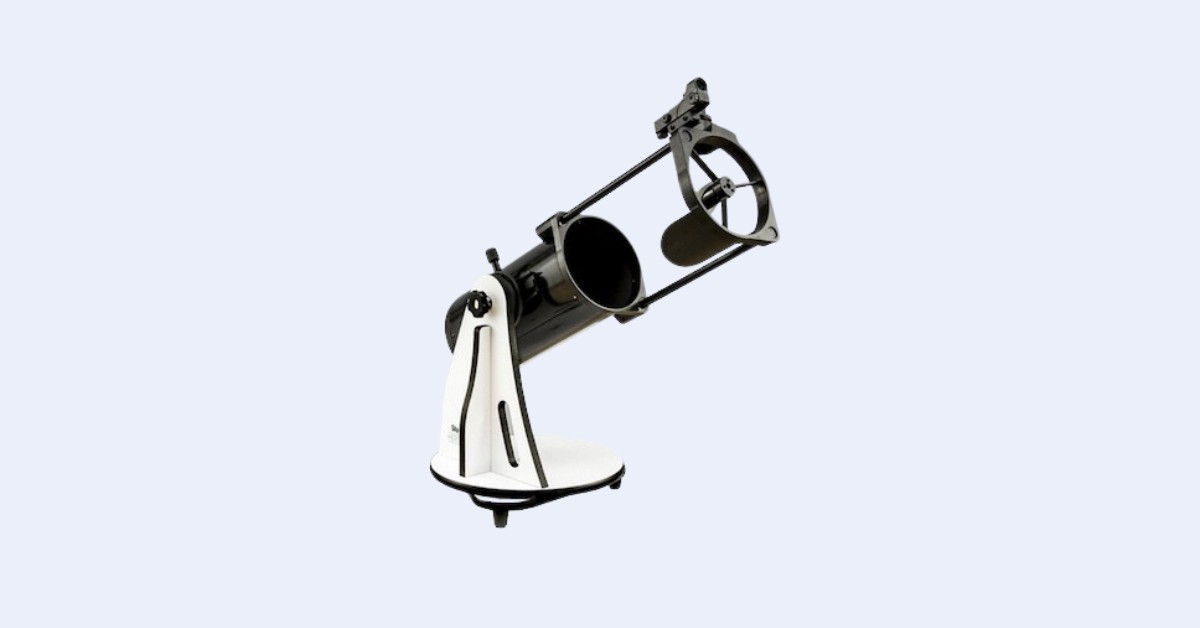
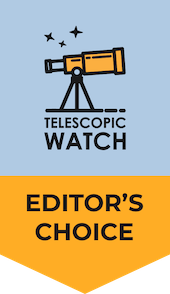

Hello Zane,
Do you have any feedback on the new Heritage 150P on a Virtuoso mount? Also, do you think if the helical focuser can be replaced with a metal focuser? Not sure if the struts can take the additional weight.
It’s a great scope, and sadly no.
Hello, I enjoy your reviews. Something I have been wondering is, if someone was able to modify using a 3d printer and change the focuser, add a shroud etc (the link is for the 130, but I would design it for the 150) https://www.printables.com/model/402468-heritage-130p-telescope-secondary-redesign, could this become a better purchase than a “typical” 6″ dobsonian? From your review, the weakest part of the telescope is
Yes, that would make it even better.
The eyepieces I have range in weight from 4.11 oz up to 6.70 oz. Adding a 3.5 oz barlow, the combined weights range from 7.61 oz up to 10.2 oz. How many ounces would you guesstimate the plastic focuser can hold before beginning to sag, and do I need to worry about breakage at 10.2 oz?
– GSO 2.5x Apochromatic Barlow Lens, 3.5 oz.
– 6mm SVBONY F9152 Redline, 4.69 oz, weight w/barlow 8.19 oz.
– 8mm Astromania Planetary, 4.7 oz, weight w/barlow 8.2 oz.
– 9mm SVBONY F9152 Redline, 6.70 oz, weight w/barlow 10.2 oz.
– 15mm Agena Astro Starguider, 5.80 oz, weight w/barlow 9.3 oz.
– 20mm SVBONY F9152 Redline, 6.00 oz, weight w/barlow 9.5 oz.
– 25mm Agena Astro Starguider, 5.90 oz, weight w/barlow 9.4 oz.
– 30mm SVBONY SV207 Super Plossl, 4.23 oz, weight w/barlow 7.73 oz.
– 32mm SVBONY SV131 Plossl, 4.11 oz, weight w/barlow 7.61 oz.
Any alternative suggestions? I don’t want to break the scope.
Thanks!
Those should all be fine
Excellente review, very helpful. Thanks.